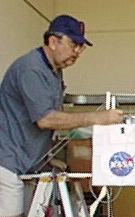Bryan Walls News home
Bryan Walls News home |
Sometime It Is Rocket Scienceweather balloons, the Internet, and streaming video for NASA |
|
Left: Linda Porter in the Spirit of Science. Credit: Bob Moder? I'm really enjoying work again! I'd gotten myself into a corner
doing research no one cared about in my previous area, basically
all by myself. Now I'm working with a team of people, and enjoying
the work.
 (Astronomy and
Astrophysics, studying stars, black holes, gamma-ray bursts,
and such). The Science Communications job is to make the research
accessible to the public, or at least to what we call the science-attentive
public. Explanations have to be at a level that someone with
a basic scientific education can understand, rather than in the
arcane terminology of a given (Astronomy and
Astrophysics, studying stars, black holes, gamma-ray bursts,
and such). The Science Communications job is to make the research
accessible to the public, or at least to what we call the science-attentive
public. Explanations have to be at a level that someone with
a basic scientific education can understand, rather than in the
arcane terminology of a given Left: Ed Myszka working on the balloon payload. Credit: Bob Moder? We have two to three science writers on staff who interview
scientists about their research. The writer turns what they learn
into an article, adding graphics and background material as needed.
They submit their article for review to the scientists, and make
any corrections needed. Then the article is reviewed by the Science
Roundtable, which includes scientists from various areas, and
representatives from the Education Office, Media Relations, Scientific
Outreach, Headquarters Media Relations, Right: The logo for the Space Science News, or Science.NASA.gov, web site. Check it out! Once the story passes muster, we do final editing, modifying, linking, and massaging it to post it on our web site (check it out at http://science.nasa.gov/). We send a message out to our mailing list (about 100,000 people have signed up) with a brief description and web-link to the article. We do about five stories a week, more or less. Posting stories (ie., this process) is a good part of my day to day job. |
.jpg) I also do special projects associated
with Science Communications. I've become the specialist for streaming
video. We sometimes include short interviews, clips from NASA
TV, or other video footage with stories. I usually convert them
into the right form so readers can see the video in their web
browser. The most fun project I've been involved with has been
streaming live video footage from our balloon launches. I also do special projects associated
with Science Communications. I've become the specialist for streaming
video. We sometimes include short interviews, clips from NASA
TV, or other video footage with stories. I usually convert them
into the right form so readers can see the video in their web
browser. The most fun project I've been involved with has been
streaming live video footage from our balloon launches.
Right: A balloon, almost ready to launch. The payload is the white boxes sitting on a ladder in front of the image. Click on the image for a larger version. Left: A top view of the payload, with six capsules of Xerogel, and 5 JustBorn Peeps Credit: Bryan Walls
|
|
More
web links More Headlines - News about me on the web |
|
|